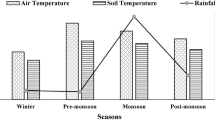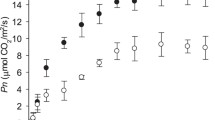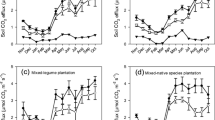Abstract
Soil respiration, canopy temperature, soil moisture, above and belowground biomass were observed in 2001, 2002, 2004 and 2005 at fenced and grazed typical Leymus chinensis steppes in Inner Mongolia. Based on soil respiration data obtained by the enclosed chamber method, diurnal and seasonal dynamics of soil respiration and their controlling factors were analyzed. The effects of grazing on diurnal and seasonal soil respirations were not significant. The diurnal patterns of soil respiration could be expressed as a one-humped curve and the lowest and highest values appearing from 1:00 to 3:00 and from 11:00 to 14:00, respectively. Canopy temperature had a strong influence on the diurnal variation of soil respiration. The rates of soil respiration rose to a seasonal maximum from the middle of June to the end of July and then gradually decreased. Soil moisture explained about 71.3% and 58.3% of the seasonal variation in soil respiration at fenced and grazed plots, respectively, and canopy temperature only 33.9% and 39.7%. Soil respiration rate, above and belowground biomass and soil moisture were significantly increased at the fenced plots compared to the grazed plots (P < 0.05), but the difference was not significant in canopy temperature. The mean soil respiration rates were 247.85 and 108.31 mgCO2 m−2 h−1 during the whole experiment at fenced and grazed plots, respectively. Soil respiration rate was enhanced significantly at the fenced plots, which might attribute to the increasing soil moisture and biomass. The response of soil respiration rate to grazing varied among different sites and might be related to local soil moisture status.
Similar content being viewed by others
References
Atjay GL, Ketner P, Duvigneaud P (1979) Terrestrial primary production and phytomass. In: Bolin B, Degens ET, Kempe S, Ketner P (eds) The global carbon cycle. John Wiley & Sons, Chichester, pp 129–181
Berntson GM, Bazzaz FA, (1996) Belowground positive and negative feedbacks on CO2 growth enhancement. Plant and Soil 187:119–131
Bouwmann AF, Germon, JC (1998) Special issue: soils and climate change: introduction. Biol Fert Soils 27:219
Bremer DJ, Ham JM, Owensby CE, Knapp AK (1998) Responses of soil respiration to clipping and grazing in a tallgrass prairie. J Environ Qual 27:1539–1548
Bryla DR, Bouma TJ, Hartmond U, Eissenstat DM (2001) Influence of temperature and soil drying on respiration of individual roots in citrus: integrating greenhouse observations into a predictive model for the field. Plant Cell Environ 24:781–790
Chen QS, Li LH, Han XG, Yan ZD, Wang YF, Yuan, ZY (2003) Influence of temperature and soil moisture on soil respiration of a degraded steppe community in the Xilin river basin of Inner Mongolia. Acta Phytoecol Sin 27:202–209 (in Chinese)
Chen SQ, Cui XY, Zhou GS, Li, LH (1999) Study on the CO2-release rate of soil respiration and litter decomposition in Stipa grandis Steppe in Xilin river basin, Inner Mongolia. Acta Bot Sin 41:645–650 (in Chinese)
Chen ZZ, Wang SP (2000) Research on Grassland Ecosystem. Science Press, Beijing, pp 9–22 (in Chinese)
Cui XY, Chen SQ, Chen ZZ (2000) CO2 release from typical Stipa grandis grassland soil. Chin J Appl Ecol 11:390–394 (in Chinese)
Davidson EA, Verchot LV, Cattanio JH, Ackerman IL, Carvalho JEM (2000) Effects of soil water content on soil respiration in forests and cattle pastures of eastern Amazonia. Biogeochemistry 48:53–69
Dong YS, Zhang S, Qi YC, Chen ZZ, Geng YB (2000) Fluxes of CO2, N2O and CH4 from a typical temperate grassland in Inner Mongolia and its daily variation. Chinese Science Bulletin 45:1590–1594
Edwards NT (1975) Effects of temperature and moisture on carbon dioxide evolution in a mixed deciduous forest floor. Soil Sci Soc Amer Proc 39:361–365
Frank AB (2002) Carbon dioxide fluxes over a grazed prairie and seeded pasture in the northern Great Plains. Environ Pollut 116:397–403
Goulden ML, Munger JW, Fan SM, Daube BC, Wofsy SC (1996) Measurements of carbon sequestration by long-term eddy covariance: methods and a critical evaluation of accuracy. Global Change Biology 2:169–182
Howard DM, Howard PJA (1993) Relationships between CO2 evolution, moisture content and temperature for a range of soil types. Soil Biol Biochem 25:1537–1546
Janssens IA, Lankreijer H, Matteucci G., et al. (2001) Productivity overshadows temperature in determining soil and ecosystem respiration across European forests. Global Change Biology 7:269–278
Jiang S (1985) An introduction on the Inner Mongolia Grassland Ecosystem Research Station, Academia Sinica. In: Inner Mongolia Grassland Ecosystem Research Station, Academia Sinica (eds) Research on Grassland Ecosystem, Science Press China 1:1–10 (in Chinese)
Keith H, Jacobsen KL, Raison RJ (1997) Effects of soil phosphorus availability, temperature and moisture on soil respiration in Eucalyptus pauciflora forest. Plant and Soil 190:127–141
Kucera CL, Kirkham DR (1971) Soil respiration studies in tallgrass prairie in Missouri. Ecology 52:912–915
Law BE, Ryan MG, Anthoni PM (1999) Seasonal and annual respiration of a ponderosa pine ecosystem. Global Change Biology 5:169–182
Lee MS, Nakane K, Nakatsubo T, Mo WH, Koizumi H (2002) Effects of rainfall events on soil CO2 flux in a cool temperate deciduous broad-leaved forest. Ecol Res 17:401–409
Li B, Yong SP, Li, ZH (1988) The vegetation of the Xilin river basin and its utilization. In: Inner Mongolia Grassland Ecosystem Research Station, Academia Sinica (eds) Research on grassland ecosystem, Science Press China, 3:84–183 (in Chinese)
Li LH, Chen ZZ (1998) Soil respiration in grassland communities in the world. (in Chinese). Chin J Ecol 17:45–51
Li LH, Han XG, Wang QB, Chen QS, Zhang Y, Yang Y, Yan ZD, Li X, Bai WM, Song SH (2002) Correlations between plant biomass and soil respiration in a Leymus chinensis community in the Xilin river basin of Inner Mongolia. Acta Bot Sin 44:593–597
Li LH, Wang QB, Bai YF, Zhou GS, Xing XR (2000) Soil respiration of a Leymus Chinensis grassland stand in the XiLin river basin as affected by over-grazing and climate. Acta Phytoecol Sin 24:680–686 (in Chinese)
Linn DM, Doran JW (1984) Effect of water-filled pore space on carbon dioxide and nitrous oxide production in tilled and non-tilled soils. Soil Sci Soc Amer J 48:1267–1272
Mathes K, Schriefer Th (1985) Soil respiration during secondary succession influences of temperature and moisture. Soil Biol Biochem 17:205–211
Moncrieff JB, Fang C (1999) A model for soil CO2 production and transport 2: application to a florida Pinus elliotte plantation. Agr Forest Meteorol 95:237–256
Raich JW, Potter CS (1995) Global patterns of carbon dioxide emissions from soils. Global Biogeochemical Cycles 9:23–36
Raich JW, Schlesinger WH (1992) The global carbon dioxide flux in soil respiration and its relationship to vegetation and climate. Tellus 44:81–89
Risser PG, Birney EC, Blocker HD, May SW, Parton WJ, Wiens, JA (1981) The true prairie ecosystem. In: US/IBP Synthesis Series 16, Hutchinson Ross Publishing Company, Stroudsburg, Pennsylvania, pp 244–246
Stark S, Strommer R, Tuomi J (2002) Reindeer grazing and soil microbial processes in two suboceanic and two subcontinental tundra heaths. Oikos 97:69–78
Tongway DJ, Ludwig JA (996) Rehabilitation of semiarid landscapes in Australia. I. Restoring productive soil patches. Restor Ecol 4:388–397
Wildung RE, Garland TR, Buschbom RL (1975) The interdependent effect of soil temperature and water content on soil respiration rate and plant root decomposition in arid grassland soils. Soil Biol Biochem 7:373–378
Wilsey BJ, Parent G, Roulet NT, Moore TR, Potvin, C (2002) Tropical pasture carbon cycling: relationships between C source/sink strength, above-ground biomass and grazing. Ecol Lett 5:367–376
Wofsy SC, Goulden ML, Munger JW, Fan SM, Bakwin PS, Daube BC, Bassow SL, Bazzaz FA (1993) Net exchange of CO2 in a mid-latitude forest. Science 260:1314–1317
Zhou GS, Wang YH (2002) Conversion of terrestrial ecosystems and carbon cycling. Acta Phytoecol Sin 26:250–254 (in Chinese)
Zhou GS, Wang YH, Jiang YL, Xu ZZ (2002) Carbon balance along the Northeast China Transect (NECT-IGBP). Science in China(Series C) 45:18–29
Author information
Authors and Affiliations
Corresponding author
Rights and permissions
About this article
Cite this article
Jia, B., Zhou, G., Wang, F. et al. Effects Of Grazing On Soil Respiration Of Leymus Chinensis Steppe. Climatic Change 82, 211–223 (2007). https://doi.org/10.1007/s10584-006-9136-0
Received:
Revised:
Accepted:
Published:
Issue Date:
DOI: https://doi.org/10.1007/s10584-006-9136-0




